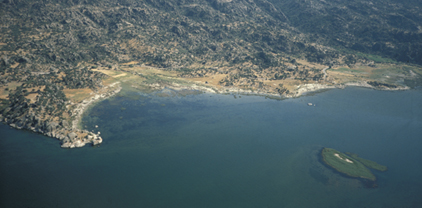
















With the exception of the karst sink-hole of Malkayası on the northern edge of the mountains, the sites of prehistoric rock paintings in the Latmos known up to now are restricted to the southern slope of the mountains, namely the area surrounding the two towns of Heraclea and Latmos (1). Some of these find places lie a few metres above the fertile shore area of Lake Bafa.
Among the find places on the southern slope of the mountains, the Valley of the Cave of Christ located to the north of the ancient town of Latmos and the rocky slope adjoining to the West are remarkable for their greater density of find places (2.3). The rich and varied range of stone tools and ceramics that have been found in this valley indicates that humans lived here over a long period of time. This period of time can be determined more closely with the help of the pottery because, just like the pottery from the Malkayası cave (see below), it shows great resemblance with the Chalcolithic pottery from Emporio on Chios, and above all with that found at Kastro Tigani on Samos, and thus belongs to the first half of the fifth millennium bc. This affinity becomes particularly clear with a vessel handle decorated with the head of a goat (?) from the Valley of the Cave of Christ and a neck- amphora from the following rock slope to the west of the valley, for which there are counterparts in the pottery from Kastro Tigani (16-19). Therefore the Latmos Mountains were part of the East Aegean cultural area during the Chalcolithic era.
During the Middle Ages, hermits withdrew to the valley. The central place of devotions for these hermits was a large, spacious cave decorated with frescoes with scenes of the life of Christ (3 No. 4-6). This cave was probably already used for ritual purposes in Chalcolithic times, as suggested by the find of a miniature vessel with a human face in a gap at the foot of the eastern rock face (7.8). Two further miniature vessels (13-15), a vase fragment with an appliquéd male figure with ram’s horns (?) on its head (20.21) and the clay figure of a bear (12) which came to light in a rock fissure in the Valley of the Cave of Christ or under the rock of the following rocky slope to the west of the valley and were presumably deposited here, may also be regarded as votive offerings.
The ‘dwelling cave’ located to the south of the Cave of Christ (3 No. 5.9-11) consists of two slanting large blocks. The enclosure with a triangular cross section is readily accessible. The space to the south of the ‘cave’ probably served as the courtyard. The finds include several tools made of stone, obsidian and silex, a spindle whorl, a fish-hook, and numerous pottery fragments.


1) The southern slope of the Latmos, to the east of Heraclea on the bay of Orluboğaz, on the left Cape Asar Burnu with the remains of the Byzantine castle of Heraclea (Photo Peter Grunwald).
1
2
3
4
5
6
7
8
9
10
11
12
13
14
15
16
17
18
19
20
21









































